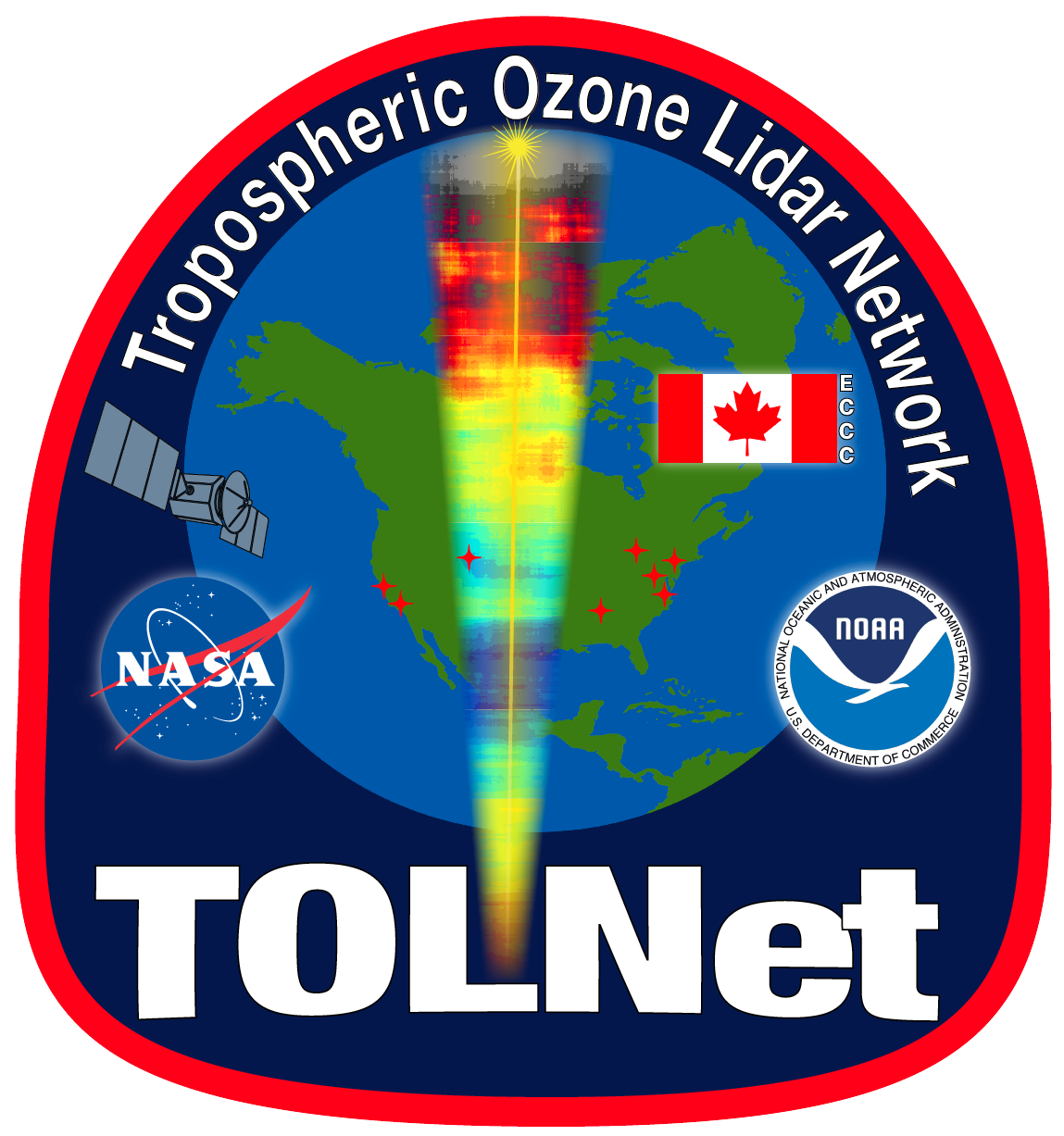
TOLNet - Tropospheric Ozone Lidar Network
Ground-based Profiling of Tropospheric OzoneProject Objectives
TOLNet was established in 2012 to provide high spatio-temporal observations of tropospheric ozone to (1) better understand physical processes driving the ozone budget in various meteorological and environmental conditions, and (2) validate the tropospheric ozone measurements of spaceborne missions.
The Importance of Ozone Profiles
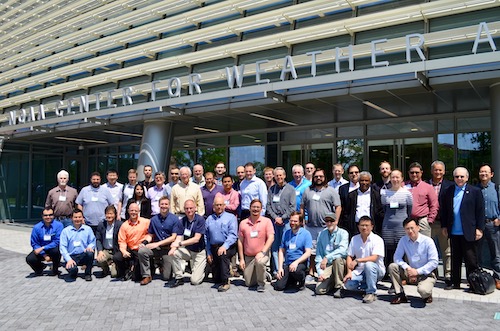
Although vital in the stratosphere, ozone has long been recognized as an air pollutant near the Earth's surface, causing health problems for humans and vegetation at high concentrations. Tropospheric ozone is also a short-lived greenhouse gas impacting climate by contributing to the Earth's global warming. Despite significant regulatory efforts and pollution-control programs developed over the past 20 years in the most densely populated regions of the globe, recent reports of continuing free-tropospheric ozone increase, for example in the western United States, have triggered the need to enhance our tropospheric ozone observation capabilities to evaluate the tropospheric ozone measurements of spaceborne missions, such as TEMPO (Tropospheric Emissions: Monitoring of POllution; http://tempo.si.edu) or TROPOMI (TROPOspheric Monitoring Instrument, http://www.tropomi.eu/).
Objectives of the Network (Through Routine Measurements and Joint Field Deployments)- Provide high spatio-temporal observations of planetary boundary layer (PBL) and free tropospheric ozone for use by the satellite, regulatory, and scientific community.
- Study the character of the atmospheric structure that current and future satellites observe and assess the fidelity with which a geostationary instrument can measure that structure.
- Discover new structures and transport processes throughout the boundary layer and upper troposphere/lower stratosphere, especially in the diurnal and vertical variation.
- Foster use of these high-resolution ozone observations to improve and evaluate the processes in air-quality forecast and chemical transport models.
- Exploit synergy with existing ground-based networks such as the NASA Pandora project, NASA MPLNet, EPA ceilometer network, existing state regulatory monitors and other networks.
- Improve the community understanding of the relationship between ozone and aerosols aloft and surface ozone and PM values both during U.S. wildfire and long-range transport events.
- Advance our understanding of processes controlling regional background atmospheric composition (including stratospheric contribution and long-range transport) and their effect on surface air quality to prepare for the geostationary satellite era.
JPL Table Mountain Facility (TMF)
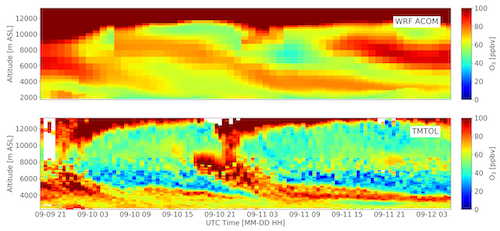
The JPL Table Mountain Facility (TMF) tropospheric ozone lidar (TMTOL, 34.38◦ N; 117.68◦ W, alt. 2285 m above sea level) has been operating routinely since 1999 to provide high quality measurements of tropospheric and lower stratospheric ozone for the Network for the Detection of Atmospheric Composition Change (NDACC) (McDermid et al., 2002). Two-hours nighttime experiments are conducted 4-5 times per week, with additional experiments conducted as needed for satellite validation, model evaluation, and air-quality studies, either during day or night.
Technical description
As of 2020, the lidar transmitter consists of a PIV-400, which contains two independent Nd:YAG lasers operating at a repetition rate of 30 Hz. Each side of the laser is followed by second and fourth-harmonic generators, giving place to two independent 266 nm beams with a pulse power of about 65 mJ. One of these two pump beams is then focused into a 3.6-m-long Raman cell filled with high pressure D2, shifting the wavelength from 266 nm to 288.9 nm (first Stokes). The other pump beam is sent to a cell filled with H2 shifting the wavelength from 266 nm to 299.1 nm (first Stokes). After passing through the Raman cells, both beams are re-collimated, expanded five times and sent into the atmosphere. The last turning mirrors are mounted on motor-controlled mirror holders, allowing for the independent pointing and alignment of the beams.
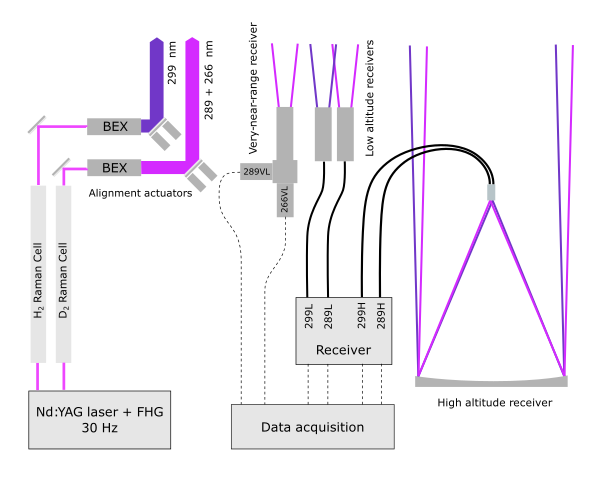
TMTOL has three pairs of receivers to accommodate the dynamic range of the upper and lower troposphere atmospheric backscatter. The high-altitude receiver, approximately covering the range between 6 and 17 km a.s.l., consists of a 0.91 m diameter parabolic mirror with a focal length of 2.54 m. On its focal plane, an arrangement of two optic fibers collects the backscattered light and directs it to a filter and detector arrangement. This dual fiber arrangement allows the receiver to have two separate fields of view (FOVs), and by pointing each transmitted beam to a separate atmospheric volume, separate the two differential absorption lidar (DIAL) wavelengths. The low-altitude receiver, covering a range between 3 and 6 km a.s.l., consists of two independent 50 mm diameter refractive telescope arrangements fiber-coupled to the corresponding filters and detectors. The signal from the detectors is then sent to high-speed transient recorders (7.5 m vertical sampling resolution) simultaneously operating in analog and photon-counting modes. One channel from either the co-located Raman water vapor lidar (TMWAL) or stratospheric ozone lidar (TMSOL) provides, together with the 299 high-intensity channel, a lower-stratospheric DIAL pair that can reach 25 km with a signal-to-noise ratio optimized for the Upper-troposphere-lower stratosphere (UTLS) region (McDermid et al., 2002). In 2019, the instrument was upgraded with a very-near-range receiver to extend the measurements down to 100-m above ground, and with full automation capability (Chouza et al., 2019).
DOI: 10.5067/Lidar/Ozone/TOLNet/NASA-JPLCitation Styles for this Dataset
NASA Ames Research Center (ARC)
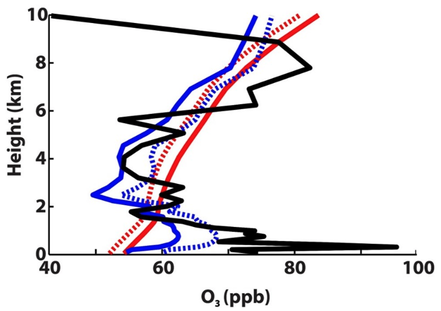
NASA Ames Research Center (ARC) has a role within TOLNet (PI contact: Matthew Johnson) focused on ozone (O3) forecasting and chemical transport modeling (CTM), data analysis, and satellite validation. The main objectives for ARC’s contribution to TOLNet are to: 1) demonstrate the application of TOLNet observations in air quality (AQ) and CTM studies, 2) exhibit the ability of TOLNet data for validating and evaluating tropospheric satellite O3 retrievals (e.g., TROPOspheric Monitoring Instrument (TROPOMI) and Tropospheric Emissions: Monitoring of Pollution (TEMPO)), and 3) facilitate the application of lidar observations in scientific studies and field campaigns.
Recent collaborative efforts have led to scientific studies in which TOLNet O3 data is of substantial importance. These studies include, but are not limited to, the evaluation of: source attribution of summer-time O3 lamina in the southeast US (Johnson et al., 2016), free-tropospheric and surface O3 over the western US (Yates et al., 2017), the impact of the North American monsoon on the vertical distribution of O3 (Granados-Munoz et al., 2017), simultaneous stratospheric intrusions occurring in the US, summer-time O3 enhancements associated with stratospheric and biomass burning sources (Kuang et al., 2017), the importance of a priori O3 profile information used in TEMPO tropospheric O3 retrievals (Johnson et al., 2018; see Fig. 1), and long-range transport of Siberian wildfire smoke during FIREX-AQ (Johnson et al., in prep.; see Fig. 2). NASA ARC also conducts forecasting in order to identify times when TOLNet can observe vital observations to contribute to large-scale field campaigns (i.e., Fire Influence on Regional to Global Environments and Air Quality (FIREX-AQ)), satellite validation, and daily observations to capture O3 events. To assist in determining opportune times for TOLNet systems to take measurements of O3 events, NASA ARC has produced an automated alert system based on WRF-Chem and GEOS-CF model forecasts of O3 and other chemical/meteorological parameters.

NOAA Chemical Sciences Laboratory TOPAZ lidar
The Tunable Optical Profiler for Aerosol and oZone (TOPAZ) lidar is a mobile, ground-based, scanning lidar system for measurement of ozone and aerosol backscatter in the lower troposphere (from near ground-level up to 6-10 km AGL). The system is currently installed in a truck with co-deployed instruments that include an in situ ozone monitor and meteorological station, and near-term plans include transfer into a larger trailer along with Doppler lidar and Pandora instruments. The base location for TOPAZ measurements is at the NOAA CSL in Boulder, Colorado (39.99 N, 105.26 W, 1674 m ASL).
The TOPAZ lidar transmitter utilizes a rapidly-tunable, all-solid-state uv laser along with an optical scanner to make differential absorption measurements of ozone concentration and aerosol backscatter along vertical and low-angle slant paths (including at, or below, horizontal as terrain permits) through the lower troposphere. The lidar receiver and data acquisition system collect and record the backscattered light signals using both analog-to-digital conversion and photon counting to accommodate maximum signal dynamic range.
TOPAZ uses the differential absorption lidar (DIAL) technique to measure ozone concentrations along the laser beam path. As this technique is based on computing the difference in the rate of change in the lidar return signals over a given range interval for a pair of laser wavelengths, any other effects that are range and wavelength dependent must be removed. These corrections include removal of differential backscatter and extinction due to aerosols (Mie scattering) and the principal atmospheric molecular components (Rayleigh scattering). An iterative technique that computes both the ozone concentration profile and the aerosol backscatter profile has been developed for TOPAZ.
TOPAZ ozone and aerosol (and in situ O3 and meteorological) data are posted in real time at the Earth System Research Laboratory site.
DOI: 10.5067/Lidar/Ozone/TOLNet/NOAA-CSL
Citation Styles for this Dataset
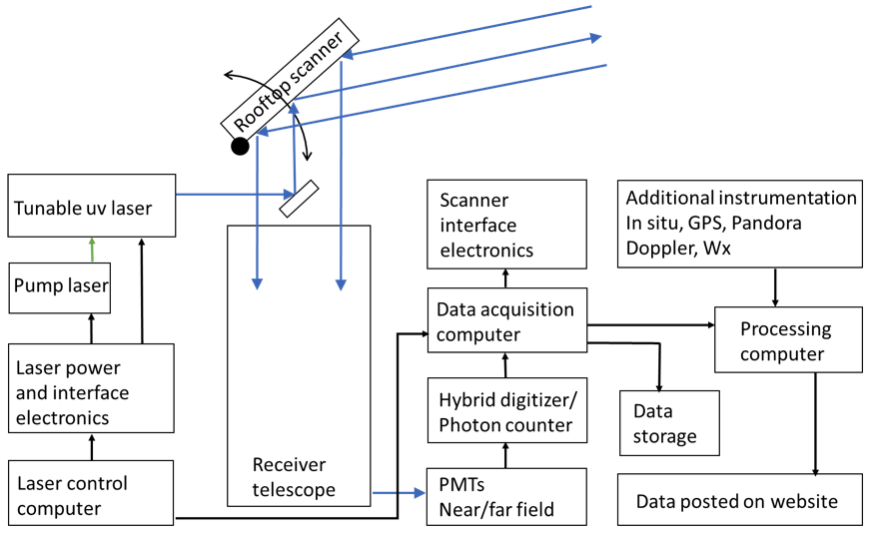
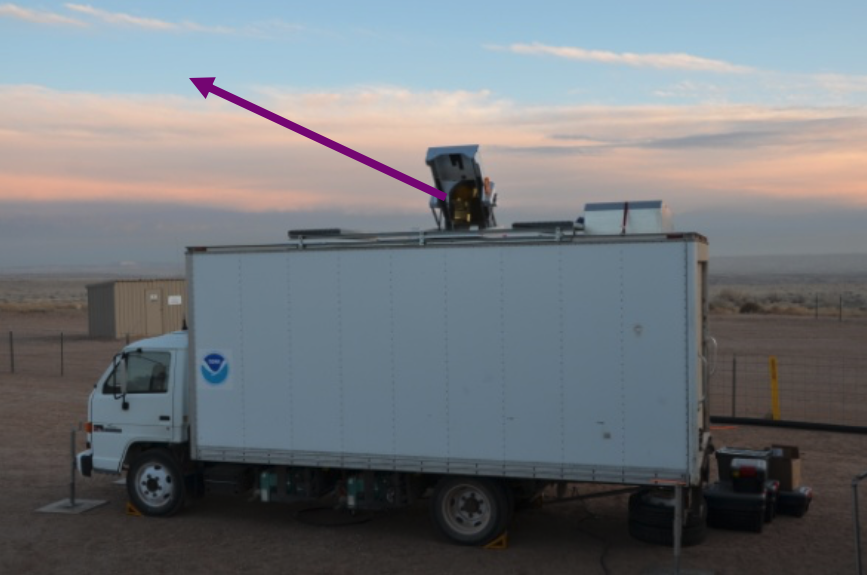
UAH RO3QET Ozone Lidar
Introduction
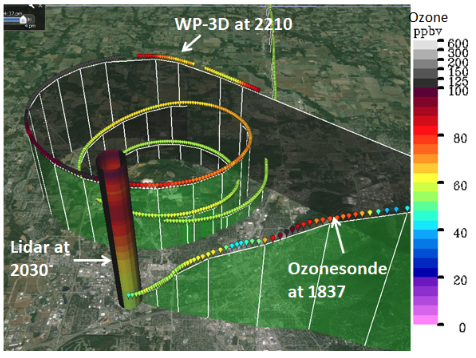
The Rocket-city Ozone (O3) Quality Evaluation in the Troposphere (RO3QET) lidar is a differential absorption lidar (DIAL) located on the campus of the University of Alabama in Huntsville (UAH) at 34.73°N and 86.65°W at 206 m asl. This lidar is one of the Tropospheric Ozone Lidar Network (TOLNet) sites and is also affiliated with the NDACC network. Huntsville represents a typical mid-size, mid-latitude city in the Southeastern U.S. and is located within a moderately polluted environment near sea-level altitude, sometimes affected by stratospheric intrusion and air pollution (e.g., due to prescribed and wild fires) transported from regional locations. Since 2008, the RO3QET lidar has been routinely providing high spatio-temporal resolution ozone profiles for satellite validation, model evaluation, and various scientific studies. Currently, this lidar is in a transition from a laboratory-based lidar with only vertical measurement to a mobile system with both vertical and scanning observation capability. In addition to the lidar observation, the UAH group has a long record of weekly ozonesonde observations (> 1000 flights since 1999) for climatology study and satellite validation.
Technical Description
The RO3QET lidar measures ozone from 0.1 km up to about 10 km with an adjustable temporal resolution that is typically specified as 10 min. The vertical resolution of the lidar retrievals varies from 150 m in the lower troposphere to 750 m in the upper troposphere in order to keep the measurement uncertainty within ±10%. The lidar also provides profiles of aerosol extinction coefficients at 299 nm.
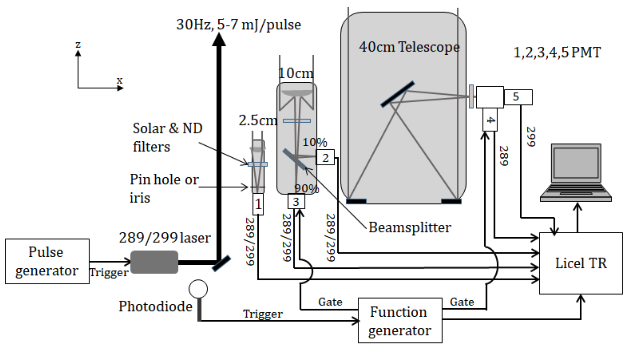
The transmitter of the lidar comprises two Raman-shifted lasers at 289 and 299 nm. Two 30-Hz, 266-nm Nd:YAG lasers pump two 1.8-m Raman cells, respectively, with mixtures of active gas and buffer gas to generate 289 and 299-nm lasers with an average pulse energy of about 5 mJ. The receiving system consists of three receivers with diameters of 2.5 cm, 10 cm, and 40 cm, respectively, and five photomultipliers (PMTs) with either short-pass filter or narrow-band filter to reduce the solar light background. Since the dynamic range of one PMT is limited, the combination of multiple PMTs extends the total measurable altitude range. Lidar signal counting is accomplished by the Licel transient recorders with both analog and photoncounting modes sampled at 40 MHz corresponding to a 3.75-m fundamental resolution. The cloud-contaminated data is filtered out by setting an appropriate threshold for the derivatives of the 299-nm laser signal. The aerosol profiles are retrieved with an iterative DIAL algorithm by assuming a constant aerosol extinction-to-backscatter ratio, typically about 60 sr. Intercomparison experiments with another aerosol lidar suggest that the RO3QET lidar is capable of measuring UV aerosol profile reliably below 6 km with the current laser output power.
More information is available at http://nsstc.uah.edu/atmchem/lidar/DIAL_data.html.
DOI: 10.5067/Lidar/Ozone/TOLNet/UAHCitation Styles for this Dataset
ECCC’s Fully Autonomous Lidar – AMOLITE
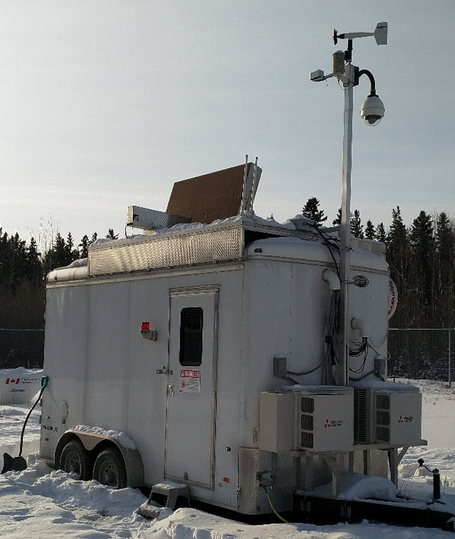
Environment and Climate Change Canada (ECCC) has been developing and building high-power autonomous lidars since 2006 for deployment to various regions across Canada. In 2014, ECCC built a fully autonomous, mobile lidar system called AMOLITE (Autonomous Mobile Ozone Lidar Instrument for Tropospheric Experiments) to simultaneously measure the vertical profile of tropospheric ozone, aerosol and water vapor (nighttime only) from near the ground to altitudes reaching 10 to 15 km. This current system uses a dual-laser, dual-lidar design housed in a single climate-controlled trailer. AMOLITE is capable of exploring the presence, vertical distribution and seasonal variability of ozone, particulate matter and water vapor in the lower atmosphere. This synergistic approach makes AMOLITE an ideal candidate to better understand boundary layer and free tropospheric processes which impact visibility, climate and air quality. The mobile capability allows measurements in a variety of scientifically relevant scenarios that have supported aircraft, satellite, in-situ ground-based measurement campaigns and model validation and verification. AMOLITE participated in a validation experiment alongside four other TOLNet ozone DIAL systems – to establish confidence in the data products and processing algorithms - before being deployed to the ECCC’s Oski-ôtin ground site (57.184 N; 111.640 W) in the Alberta oil sands region in November 2016 through to September 2019.
Technical Description
The AMOLITE instrument uses three different lidar techniques to measure different atmospheric constituents: a Mie backscatter lidar to measure the vertical profile of aerosol at three different wavelengths, a DIfferential Absorption Lidar (DIAL), based on a CO2 Raman cell, to measure the vertical ozone profile and a Raman lidar to measure the water vapor profile. The two lidars share the same optical rack and computer hardware interface. The aerosol/water vapor lidar transmitters (providing redundancy) are three wavelength (355nm, 532 nm, 1064nm) Continuum Nd:YAG Inlite III-20 lasers sharing the same beam path through remotely operated translation stages and encoded steering mirrors. The seven-channel receiver (attached to a 14” Celestron telescope) measures the backscatter at each of the emitted wavelengths as well as the depolarization at 355 nm, the nitrogen Raman channels at 387 nm and 607 nm and the water vapor Raman channel at 407 nm. All of the channels, except the 1064 nm channel (APD detector), use LICEL photomultiplier tubes coupled into a LICEL analog/photon counting transient recorder to increase the dynamic range. The collected data, are averaged, to produce aerosol profiles from 100 m to 15 km agl every minute and water vapor profiles from 100 m to 10 km agl every 5 minutes. The ozone DIAL transmitters are Continuum Inlite III-20 lasers operating at 266 nm. The laser pumps a 1 m long CO2-filled Raman cell directed zenith by a steering mirror that is broadband coated from 266 nm to 320 nm. The differential pair chosen for the DIAL is the second and third Stokes lines from the Raman conversion, namely 287 nm and 299 nm. The two wavelengths are separated out via the detector block attached to another 14” Celestron telescope, where the signals from the LICEL photomultiplier tubes are directed into a LICEL analog/photon counting transient recorder. A slight signal delay is imposed on the DIAL system to minimize cross-talk between the two LIDAR systems. The single telescope design is capable of measuring ozone as low as 400 m above ground level (agl) to altitudes reaching 15 km during the night every 5 minutes. In 2019 a small telescope receiver was added to reduce the overlap to approximately 150m agl. AMOLITE operates 24 hours a day, seven days a week except during precipitation events and the data are updated hourly to a website providing near real-time capability. A 30 day continuous ozone plot below shows the advantage of a fully autonomous lidar system.
DOI: 10.5067/Lidar/Ozone/TOLNet/ECCC
Citation Styles for this Dataset
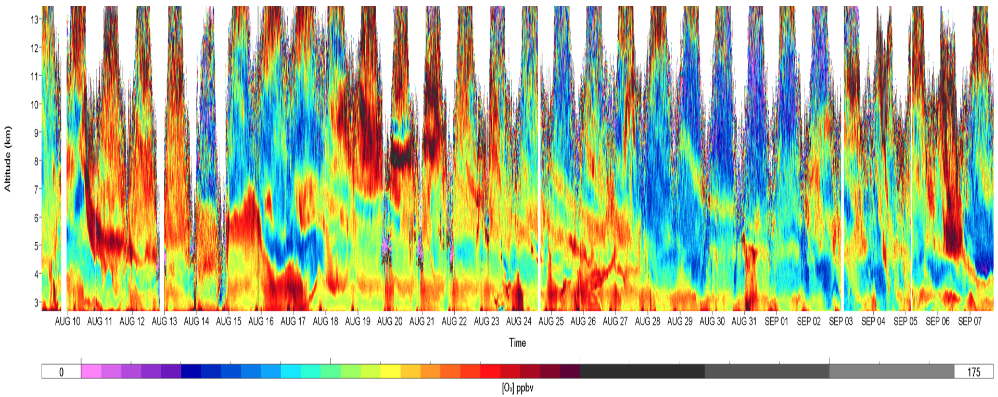
CCNY New York Tropospheric Ozone Lidar System (NYTOLS)
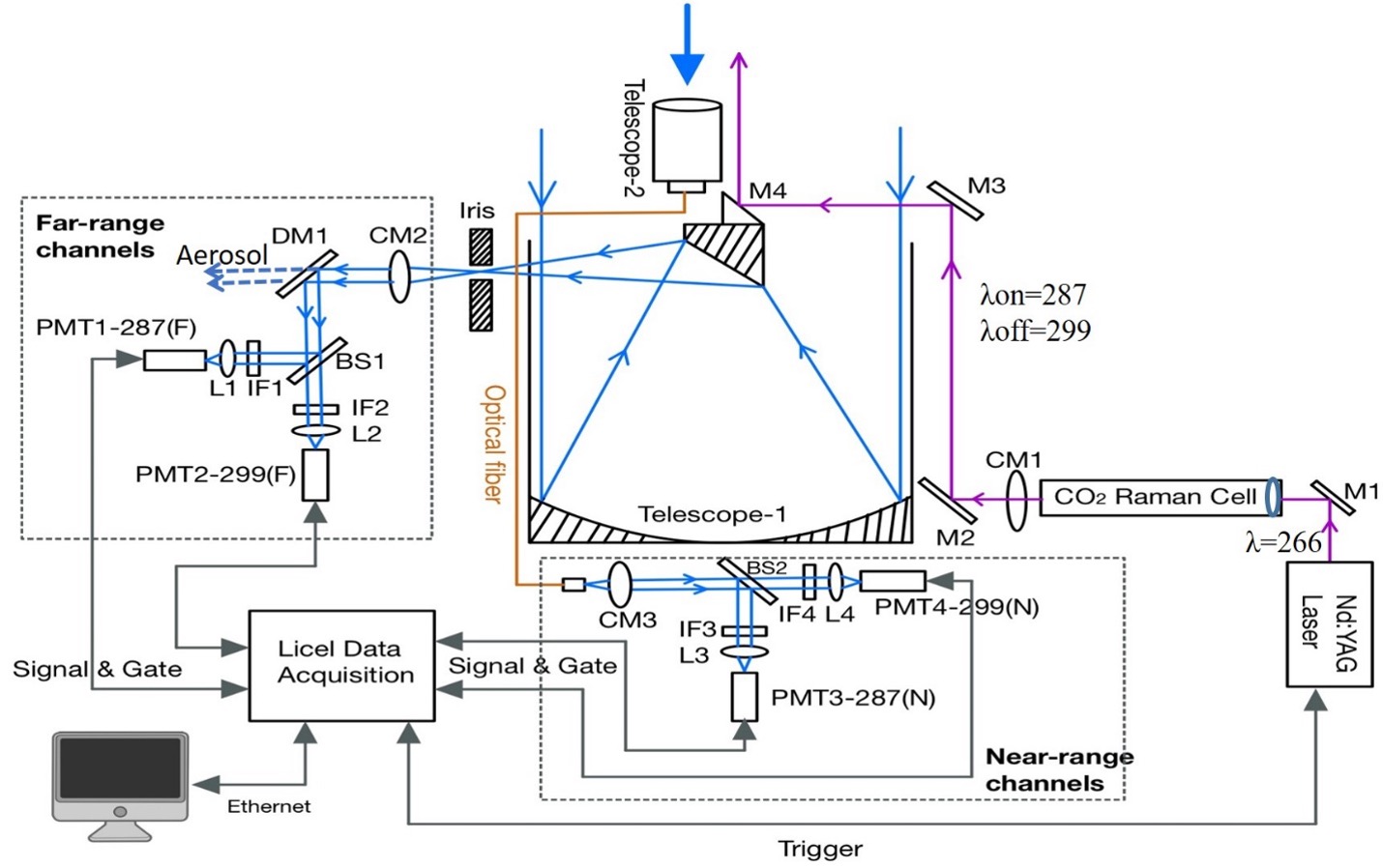
The ground-based CCNY Tropospheric Ozone DIAL was built and has made regular observations at CCNY campus (40.821° N, 73.949° W, 90 meters ASL) in New York City (NYC) urban area since spring 2022. The system consists of one transmitter, two receivers for far-range and near-range detection, and four receiving channels for signal detection and data acquisition, as shown in Figure 1. In addition, there are other co-located measurements including a five-wavelength Raman-elastic Lidar, a Coherent Doppler Wind Lidar (Leosphere Windcube 200S), a Lufft Ceilometer (CHM15k), a microwave radiometer (Radiometrics MP-3000A), CIMEL Sunphotometer as part of the NASA AeRoNet, PANDORA spectrometer (Global PANDONIA Network), and a ground air quality station operated by NYS Department of Environmental Conservation.
Transmitter
The laser transmitter is a quadrupled Nd:YAG laser (Quantel Q-Smart 450 by Lumibird, 266 nm, 50 mJ at 20 Hz) pumped CO2-filled Raman cell. The “on” and the “off” wavelengths at 287.2 nm (S2) and 299.1 nm (S3) are generated through the Stimulated Raman Scattering (SRS). The stainless steel Raman cell is 1-m long and filled with the CO2 at 150 psi pressure. The laser beam (266 nm) is focused by a f=500 mm lens that is also the input window of the Raman Cell. The output beams from the Raman cell including the fundamental and Stokes orders are collimated and steered to the atmosphere by three folding mirrors (M2, M3, M4). More details can be seen in Li et al. (2022 and 2023).
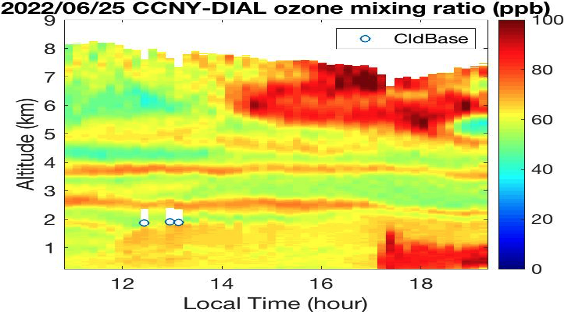
Receiver
The receivers include a large Newtonian telescope (diameter 50.8 cm, F#3.5) for the far-range ozone detection (1.0 – 8.5 km) and a small telescope constructed by a UV Plano-Convex lens (diameter 5.08 cm, F#3) for the near-range ozone (O3) detection (0.2 – 1.2 km). The current configuration of this O3-DIAL system shares the large telescope with a multi-wavelength Mie-Raman aerosol lidar. A dichroic mirror (DM1 in Fig.1, Semrock) reflects the light shorter than 325 nm into the ozone far-channel receiver optics, and allows the longer-wavelength signals passing through to the aerosol lidar receiver optics. For the near-range ozone detection, a multimode optical fiber (NA=0.22, Thorlab) guides the received light signals to the receiver optics and detectors. In each of the 4 receiver channels, a narrow-band interference filter (Alluxa, FWHM<1-nm, peak transmittance ~ 40% -50 %) is inserted in front of the detector. The photomultiplier tubes (PMT, Hamamatsu R9880U-113) are used for the signal detection while the Licel Transient recorders (TR40-16bit-3U, 40MHz and 16-bit for A/D and max. 800Hz for Photon-Counting) are used for the data acquisition. The transient recorders are connected to the computer via Ethernet cable. A trigger module from Licel Company is used to synchronize the laser emission, PMT gate-on or delay time and signal acquisition bins. The raw data is recorded and stored with 1-min average and 8000 bins (30-km altitude), and displayed by LabView software program.
Observation example
The observations from CCNY ozone DIAL have indicated high ozone formation in the Planetary-Boundary-Layer (PBL) during summer heatwave days, and aloft ozone in the free troposphere in NYC area as shown in Fig. 2. It can be seen that the ozone concentrations dramatically increase with the values greater than 70 ppb after 17:00 EDT below 1-km altitude on June 25, 2022. Such abrupt or sharp increase of ozone concentrations below 1-km altitude in the late afternoon is likely associated with the sea-breeze recirculation that transports high O3 over the water in NJ/NY Bight to CCNY site. In addition, the horizontal wind directions at CCNY weather station indicate a clear shift from the prevailing Northwest to Southeast at around 17:00 EDT, which indicates air transport from the NY/NJ Bight. Meanwhile, ground-level O3 at the different AQ stations show a timing shift for the O3 peak from Southern Long Island to New York City.
References
Dingdong Li, Yonghua Wu, Thomas Legbandt, Mark Arend, Fred Moshary, “Tropospheric Ozone Differential Absorption Lidar (DIAL) observation during heat wave events at New York City Area”, AMS Annual Meeting, Jan. 8-12, 2023, Denver, Colorado. https://ams.confex.com/ams/103ANNUAL/meetingapp.cgi/Paper/421568
Dingdong Li, Yonghua Wu, Thomas Legbandt, Mark Arend, Maggie Liang, Fred Moshary, Tropospheric Ozone DIAL Development at NYC area, the 30th International Laser Radar Conference (ILRC, Virtual), June 26th – July 1st, 2022. https://meeting-info.org/wp-content/uploads/2022/05/214_Li-3.pdf?6bfec1&6bfec1
GSFC TROPospheric OZone (TROPOZ) DIAL
The ground based GSFC TROPOZ DIAL has been routinely taking measurements in the Baltimore-Washington D.C. region (Greenbelt, MD 38.99° N, 76.84° W, 57 meters ASL) since 2013, which is described in depth in Sullivan et al. (2014). The TROPOZ has been designed and installed in a 13 m transportable trailer. Since the initial installation, the TROPOZ has been deployed for several science investigations, including NASA’s DISCOVER AQ (2014), KORUS-AQ, OWLETS-1/2, LISTOS, and TROLIX campaigns.
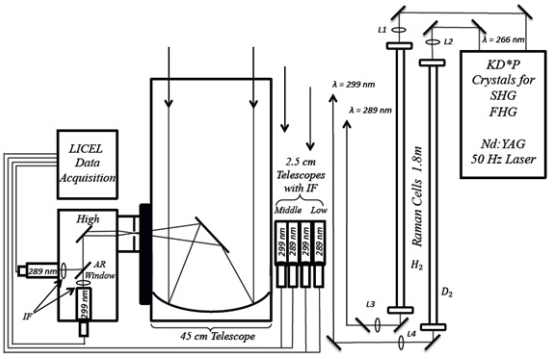
Transmitter
The transmitter for the system has been optimized for the conversion of the fundamental to the fourth harmonic at a wavelength of 266 nm at a repetition rate of 100 Hz. The beams pass through converging lenses, which focus each beam waist near the center of a 1.8 m long Raman tube filled with hydrogen or deuterium. Helium was introduced in the Raman tube in order to yield the highest possible Raman conversion of pump photons into 1st Stokes shift photons. The TROPOZ final pressure combination to generate 289 nm was 21 bar D2/ 28 bar He and 14 bar H2/ 42 bar He to generate 299 nm. The typical transmitted energies for the TROPOZ measurements are 12 (299 nm) and 16 (289 nm) mJ per pulse.
Receiver
The receiver for the TROPOZ is a large 45 cm diameter Newtonian telescope for detecting 289/299 nm at higher altitudes in the free troposphere and four smaller 2.5 cm refracting telescopes to obtain signal near the surface for 289/299 nm. For the 45 cm telescope, the lidar return is focused at a field stop to produce a 1.0 mrad field of view (FOV). After the field stop, all ambient and laser light is reflected or transmitted using optical elements, such as beam splitters and interference filters, to ensure each photomultiplier tube (PMT) is only receiving the proper spectral signal. The 2.5 cm telescopes have a much wider FOV, 10.0 mrad, for the measurement of near field signals. In each of the channels, narrow band (<.2 nm FWHM) interference filters are implemented to decrease the amount of ambient solar light. This improves the signal-to-noise ratio (SNR) in order to achieve ozone retrievals to upwards of 12 km AGL during daytime hours and 14 km AGL during nighttime hours. Neutral density filters are placed in front of the detectors to reduce the large signal strengths that can cause non linear saturation effects in the detector system. Once these saturation effects are eliminated, the higher signal (near field) channels can be joined to the lower signal (far field) channels to increase the dynamic range of the overall lidar system. To further help prevention of saturation effects associated with the detector photocathode, the individual PMTs have been constructed with electronic gating capabilities. The electronic gates are set at specific altitudes in order to restrict known saturated signals from ever making it downstream into the data acquisition system. Individual photons are then counted by a transient recorder at a maximum counting rate of 300 MHz. The data acquisition process is controlled by LabView software and a real time display of ozone concentrations is available during observations.
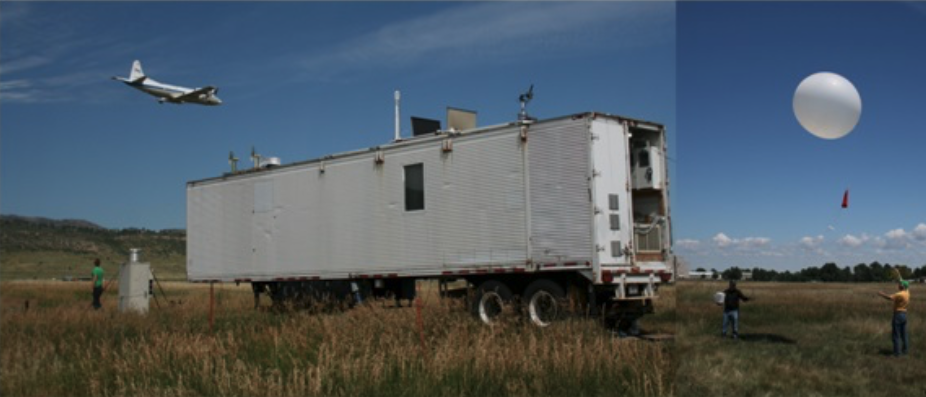
References
J. T. Sullivan, T. J. McGee, T. Leblanc, G. K. Sumnicht, and L. W. Twigg. Optimization of the GSFC TROPOZ DIAL retrieval using synthetic lidar returns and ozonesondes - Part 1: algorithm validation. Atmospheric Measurement Techniques Discussions, 2015 (Submitted).
J. T. Sullivan, T. J. McGee, R.J. De Young, G. K. Sumnicht, L. W. Twigg, D. Pliutau, W. Carrion, and T. Knepp. Results from the NASA GSFC and LaRC ozone lidar intercomparison: New mobile tools for atmospheric research. Journal of Atmospheric and Oceanic Technology, 2014 (Submitted).
J. T. Sullivan, T. J. McGee, G. K. Sumnicht, L. W. Twigg, and R. M. Hoff. A mobile differential absorption lidar to measure sub-hourly fluctuation of tropospheric ozone profiles in the Baltimore - Washington, D.C. region. Atmospheric Measurement Techniques, 7(10):3529–3548, 2014.
DOI: 10.5067/Lidar/Ozone/TOLNet/NASA-GSFC
Citation Styles for this Dataset
Langley Mobile Ozone Lidar
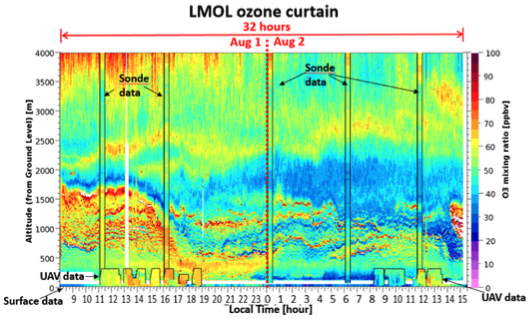
Introduction
The Langley Mobile Ozone Lidar (LMOL) is a compact differential absorption lidar that provides atmospheric O3 and aerosol profiles from its home base at NASA Langley Research Center in Hampton, Virginia as well as multiple field campaigns since 2014. The system is mounted in an environmentally controlled trailer to enable unattended operation and mobility and can be relocated with a pickup truck. LMOL results have been used to study the temporal evolution of the vertical structure of boundary layer processes, stratospheric intrusions, long-range transport of wildfire emissions, coastal recirculation of pollutants, ship emission titration events, and other complex atmospheric processes. Data has also been utilized in a variety of atmospheric modeling and satellite studies. Our operations can be complimented with co-located ozonesondes launches, in-situ trace gas, PANDORA, ceilometer, wind lidar, and UAV measurements to provide a comprehensive suite of measurements. In 2020, we started to investigate adding a SO2 lidar profile measurement and is expected to be part of our future capabilities.
Technical information
LMOL utilizes a ultra-violet tunable Ce:LiCAF laser oscillator produces time multiplexed pulses at two UV wavelengths in the same laser beam that are transmitted in a zenith direction into the atmosphere. Two co-aligned telescope receivers capture the backscatter light that allow for near surface (0.1 to 1.5 km) and far-range (1.5 to 10 km) signal retrievals. The light from both telelscopes are fiber-coupled to housings that include spectral bandpass filters and photo-muliter tube detectors. The outputs from the detectors are sent to a Licel data system that time demultiplexes and uses analog and photon counting techniques to maximize signal dynamic range. LMOL processed data files include profiles of O3 mixing ratio in ppbv, O3 number density in molec/m-3, combined standard uncertainties, profile vertical resolution as a function of height, as well as air pressure, temperature and densities associated with the mixing ratio determination. Typical profile temporal resolution is 5 minutes, and can be modified as needed for specific studies depending the trade-off desired between vertical v. time resolution. The LMOL processing protocols, error propagation, file formats, and content follow the standardized Tropospheric Ozone Lidar Network (TOLNet) for data quality and consistency within the network.
DOI: 10.5067/Lidar/Ozone/TOLNet/NASA-LaRC
Citation Styles for this Dataset
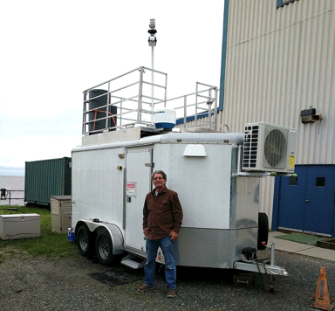

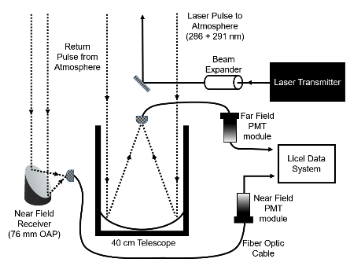
Hampton University
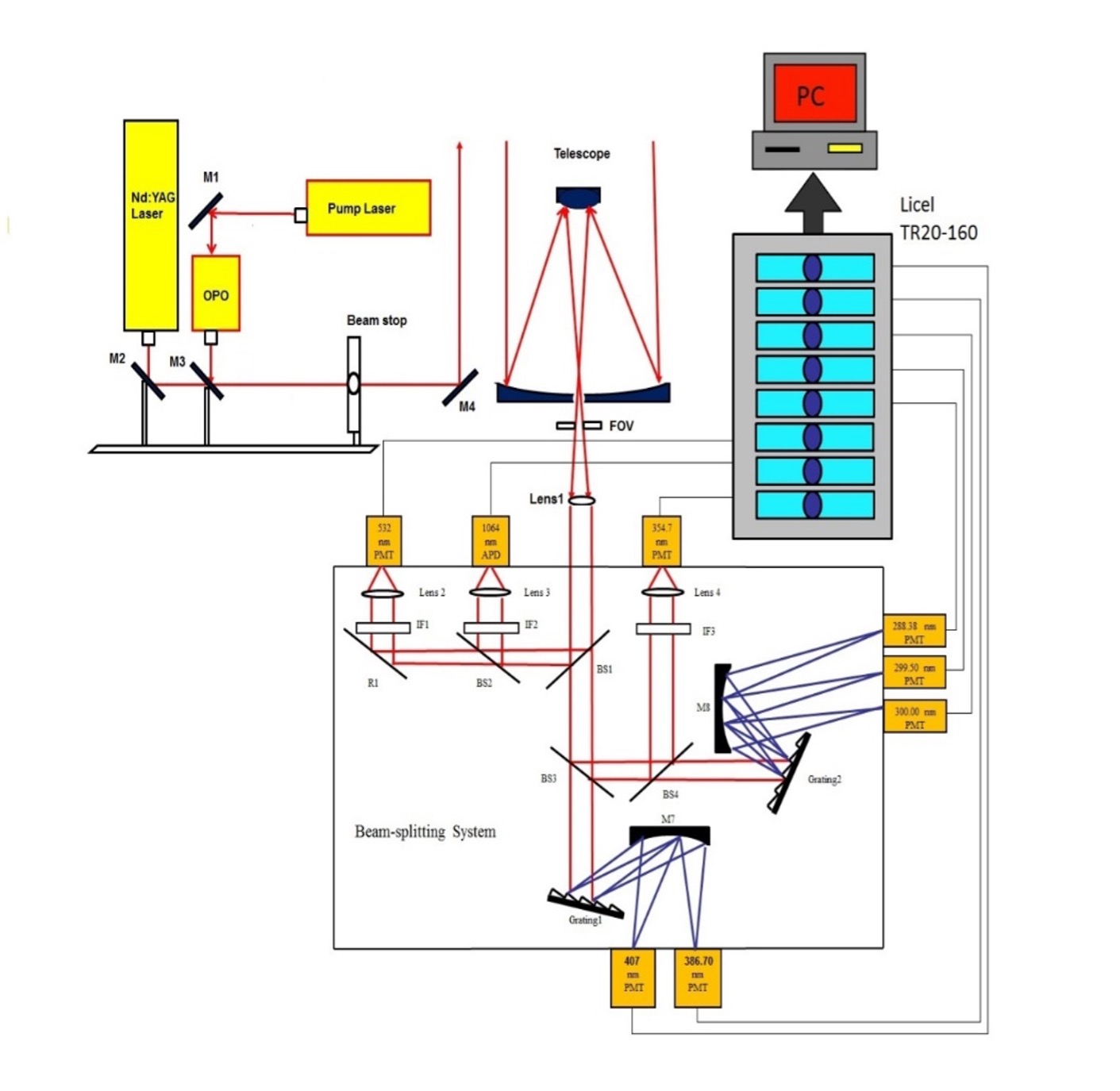
The Hampton University Lidar Laboratory is in Turner Hall Observatory (37.02° N, 76.34° W) and an altitude of 12 meters above sea level. Lidar measurements at Hampton University have contributed to air quality, wind energy and meteorological studies in support of multiple agencies (NASA, NOAA, DOD-Army Research Laboratory and the U.S. EPA). The HU lidar system consists of a zenith-viewing Nd:YAG laser that operates at three fixed wavelengths (1064, 532, and 355 nm), a 48-inch non-coaxial Cassegrainian-configured telescope receiver, a light separation system that uses beam splitters and interference filters, a detecting system including photomultiplier tubes (PMT) and avalanche photodiodes (APDs) and a Licel optical transient recorder. A schematic of the lidar system is shown in Fig .1. The system can be configured to measure elastic scattering from aerosols and clouds at the three laser output wavelengths, and at the same time measure Raman scattering excited by the 355-nm laser pulses. High-resolution (7.5 m) backscatter measurements extend from the boundary layer and free troposphere to the lower and middle stratosphere (~30 km). A tunable optical parametric oscillator (OPO) allows the lidar transmitter to have a wavelength tuning range from 192 nm to 2750 nm. A steering mirror whose axis is aligned with a receiving telescope axis directs these laser outputs into the atmosphere. The laser backscatter is collected by either a 14- or 48-inch diameter telescope, if measuring in the troposphere or stratosphere, respectively. The backscattered photons are split in a beam separation unit that combines filters and two blazed grating systems for dispersion of the photons into various channels. Using filters and a grating system makes a beam-splitting system simple, compact, and easy to change or add other spectral channels for measurements. The photons are focused on PMTs and APD and recorded by a Licel data-collecting system for measurements of aerosols and trace gases (water vapor, ozone or nitrogen dioxide).